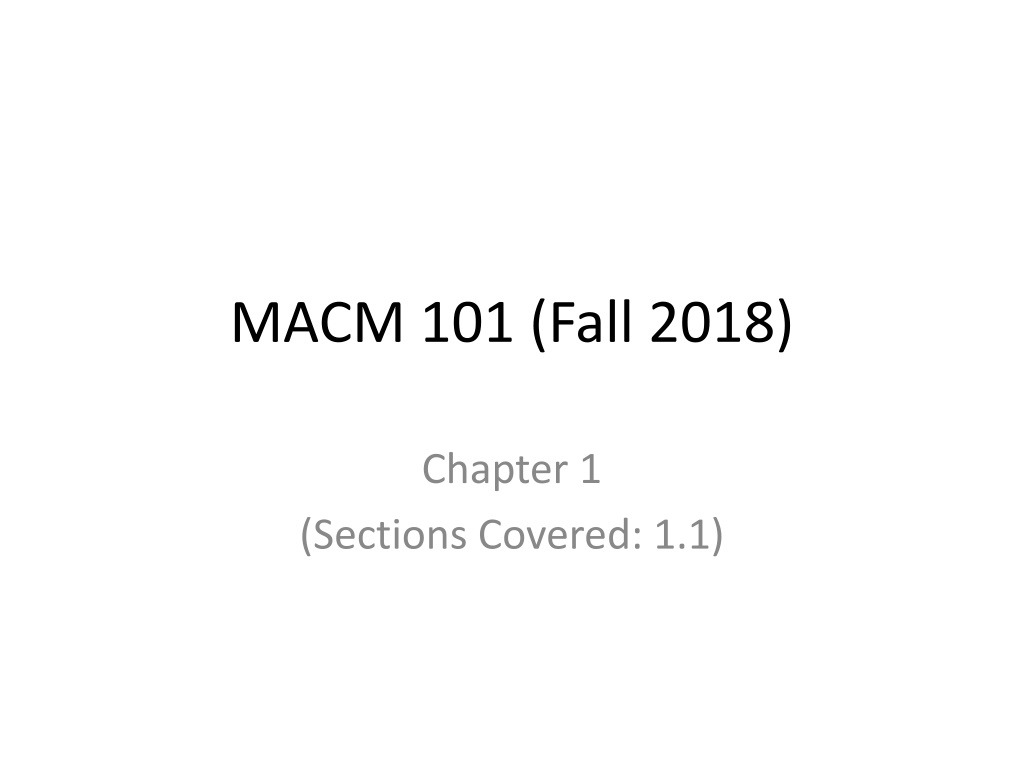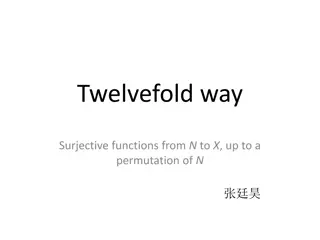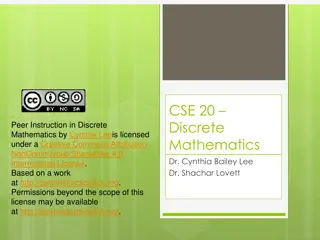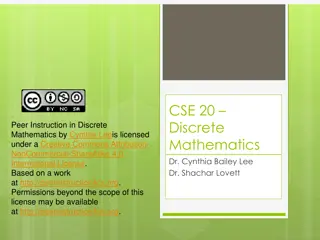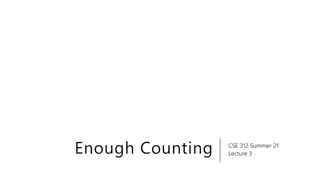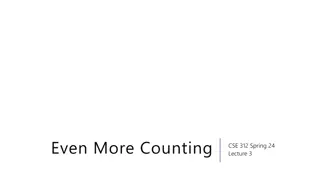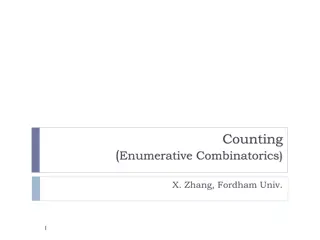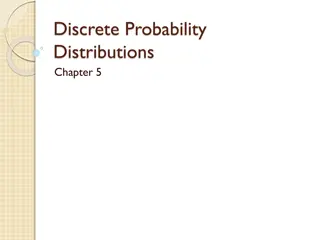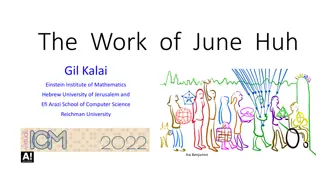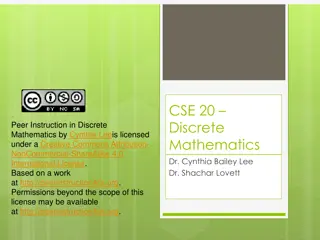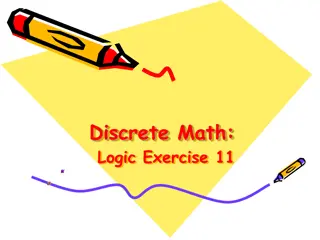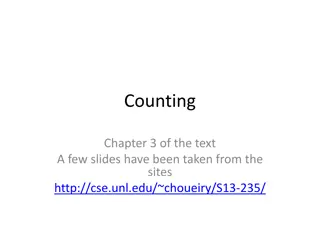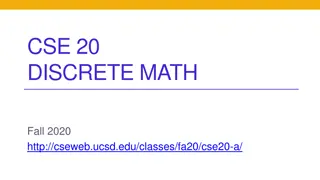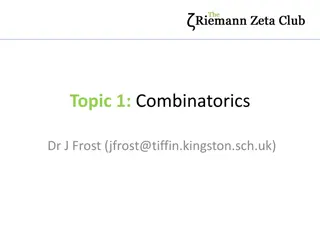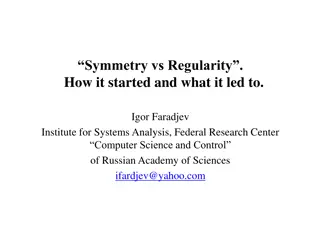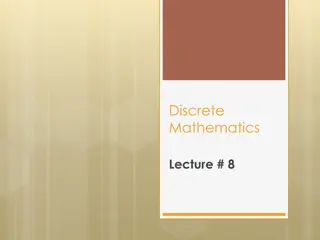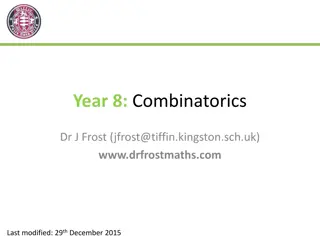Understanding Combinatorics in Discrete Mathematics
Combinatorics, a key facet of discrete mathematics, explores the arrangement of objects and finds applications in various fields like discrete probability and algorithm analysis. The Rule of Sum, a fundamental principle, dictates how tasks can be accomplished when they cannot be done simultaneously. Through examples and explanations, the concept of combinatorics and the Rule of Sum are elucidated, showcasing how to calculate possible ways of ordering drinks or selecting representatives, demonstrating the essence of counting principles in problem-solving.
Download Presentation

Please find below an Image/Link to download the presentation.
The content on the website is provided AS IS for your information and personal use only. It may not be sold, licensed, or shared on other websites without obtaining consent from the author. Download presentation by click this link. If you encounter any issues during the download, it is possible that the publisher has removed the file from their server.
E N D
Presentation Transcript
MACM 101 (Fall 2018) Chapter 1 (Sections Covered: 1.1)
List of sections covered Chapter 1 (Fundamental Principles of Counting) The rules of sum and product (1.1)
Combinatorics Combinatorics, the study of arrangements of objects, is an important part of discrete mathematics. Combinatorics are used in Discrete probability: What is the probability to guess a 6-symbols password in the first attempt? Analysis of algorithms: Why a comparison-based sorting algorithm cannot be more efficient than cnlogn for any constant c. What is the growth rate of the running time of an algorithm as the input size gets doubled? (We need to do this without writing a code!)
The Rule of Sum If the first task can be performed in m ways, while a second task can be performed in n ways, and the two tasks cannot be performed simultaneously, performing either task can be accomplished in any one of m + n ways.
Example A customer selects a drink. There are two categories of drinks: hot drinks and cold drinks. The hot drink selections are {coffee, tea, hot cocoa}. The cold drinks selections are {milk, orange juice}. How many possible ways can he order a drink?
Example A customer selects a drink. There are two categories of drinks: hot drinks and cold drinks. The hot drink selections are {coffee, tea, hot cocoa}. The cold drinks selections are {milk, orange juice}. How many possible ways can he order a drink? Crucial observation: none of the drinks is categorized as both a hot drink or a cold drink. Ans: 3 + 2 = 5 (applying sum rule)
The Rule of Sum Alternately If a task can be done either in one of m ways and in one of n ways to do the second task, where none of the set of m ways is the same as any of the n ways, then there are m + n ways to do the task.
The Rule of Sum Example The mathematics department must choose either a student or a faculty member as a representative for a university committee. How many choices are there for this representative if there are 37 members of the mathematics faculty and 83 mathematics majors and no one is both a faculty member and a student.
The Rule of Sum Example The mathematics department must choose either a student or a faculty member as a representative for a university committee. How many choices are there for this representative if there are 37 members of the mathematics faculty and 83 mathematics majors and no one is both a faculty member and a student. Solution: By the sum rule it follows that there are 37 + 83 = 120 possible ways to pick a representative.
The Rule of Sum If the first task can be performed in m ways, while a second task can be performed in n ways, and the two tasks cannot be performed simultaneously, performing either task can be accomplished in any one of m + n ways. Example: A deck of cards. How many ways can one draw a heart? How many ways can one draw a heart or a spade? .... a heart or a king of spade .... a king? .... a heart or a king?
The Rule of Sum If the first task can be performed in m ways, while a second task can be performed in n ways, and the two tasks cannot be performed simultaneously, performing either task can be accomplished in any one of m + n ways. Example: A deck of cards. How many ways can one draw a heart? (13 ways) How many ways can one draw a heart or a spade? (13 + 13 = 26 ways) .... a heart or a king of spade? (13 hearts or 1 king 14 ways.) .... a king? (4 ways) .... a heart or a king? (13 hearts (includes 1 king) + 3 other kings = 14 ways)
The Rule of Product If a task can be broken down into first stage and second stage, and if there are m possible outcomes for the first stage and if, for each of these outcomes, there are n possible outcomes, the total procedure can be carried out, in the designated order, in m.n ways.
Example Consider a restaurant that has a breakfast special that includes a drink, a main course, and a side. The set of choices for each category are: drink: {coffee, orange juice} main course: {pancakes, eggs} side: {bacon, sausage, hash browns} How many different breakfast choices are there?
Example Consider a restaurant that has a breakfast special that includes a drink, a main course, and a side. The set of choices for each category are: drink: {coffee, orange juice} main course: {pancakes, eggs} side: {bacon, sausage, hash browns} (coffee, pancakes, bacon) is one particular breakfast combination. (a triple is a breakfast choice) Answer: 2 . 2. 3 = 12 (product rule)
The Rule of Product Example: How many bit strings of length eight are there? Solution: 10011101 is an 8-bit binary string. Since each of the eight bits is either a 0 or a 1, the answer is 28= 256.
The Rule of Product Example: How many different license plates can be made if each plate contains a sequence of three uppercase English letters followed by three digits?
The Rule of Product Example: How many different license plates can be made if each plate contains a sequence of three uppercase English letters followed by three digits?
The Rule of Product Example: How many different license plates can be made if each plate contains a sequence of three uppercase English letters followed by three digits? Solution: By the product rule, there are 26 26 26 10 10 10 = 17,576,000 different possible license plates.
The Rule of Product Example: A new company with two employees rents a floor of a building with 12 offices. How many ways are there to assign different offices to these two employees? The office to the first employee can be done in 12 ways. After the first assignment, the office to the second employee can be assigned in 11 ways. By the product rule, there are 12.11 = 132 ways to assign 12 offices to two employees. A tuple (employee #1 office, employee #2 office) is an assignment.
Combining the sum and the product rule Example: Suppose statement labels in a programming language can be either a single letter or a letter followed by a digit. Find the number of possible labels. Solution: Use both the sum and the product rule. 26 + 26 10 = 286
Basic Counting Principles: Subtraction Rule Subtraction Rule: If a task can be done either in one of n1ways or in one of n2ways, then the total number of ways to do the task is n1 + n2minus the number of ways to do the task that are common to the two different ways.
The Rule of Sum Example: A deck of cards. How many ways can one draw a heart? (13 ways) How many ways can one draw a heart or a spade? (13 + 13 = 26 ways) .... a heart or a king of spade? (13 hearts or 1 king 14 ways.) .... a king? (4 ways) .... a heart or a king? (13 hearts (includes 1 king) + 3 other kings) 13 hearts + 4 Kings -1 King common
Combining the sum and the product rule Combining the sum and product rule allows us to solve more complex problems. Counting Passwords Example: Each user on a computer system has a password, which is either seven or eight characters long, where each character is an uppercase letter or a digit. Each password must contain at least one digit. How many possible passwords are there?
Counting Passwords Solution: Let P be the total number of passwords, and let P7and P8be the number of passwords of length 7 and 8 respectively. By the sum rule P = P7+P8.
Counting Passwords Solution: Let P be the total number of passwords, and let P7and P8be the number of passwords of length 7 and 8. By the sum rule P = P7+P8. To find each of P7and P8, find the number of passwords of the specified length composed of letters and digits and subtract the number composed only of letters.
Counting Passwords Solution: Let P be the total number of passwords, and let P7and P8be the number of passwords of length 7 and 8. By the sum rule P = P7+P8. To find each of P7and P8, find the number of passwords of the specified length composed of letters and digits and subtract the number composed only of letters. . P7= 367 267= 78,364,164,096 8,031,810,176 = 70,332,353,920.
Counting Passwords Solution: Let P be the total number of passwords, and let P7and P8be the number of passwords of length 7 and 8. By the sum rule P = P7+P8. To find each of P7and P8, find the number of passwords of the specified length composed of letters and digits and subtract the number composed only of letters. . P7= 367 267= 78,364,164,096 8,031,810,176 = 70,332,353,920. P8= 368 268= 2,821,109,907,456 208,827,064,576 = 2,612,282,842,880. Consequently, P = P7+P8= 2,682,615,196,800.
Counting Passwords Why can we not compute P7as follows: P7= 366x 10 = 21,767,823,360
Internet Addresses Version 4 of the Internet Protocol (IPv4) uses 32 bits. Class A Addresses: used for the largest networks, a 0,followed by a 7-bit netid and a 24-bit hostid. Class B Addresses: used for the medium-sized networks, a 10,followed by a 14-bit netid and a 16-bit hostid. Class C Addresses: used for the smallest networks, a 110,followed by a 21-bit netid and a 8-bit hostid. Neither Class D nor Class E addresses are assigned as the address of a computer on the internet. Only Classes A, B, and C are available. 1111111 is not available as the netid of a Class A network. Hostids consisting of all 0s and all 1s are not available in any network.
Counting Internet Addresses Example: How many different IPv4 addresses are available for computers on the internet?
Counting Internet Addresses Example: How many different IPv4 addresses are available for computers on the internet? Solution: Use both the sum and the product rule. Let x be the number of available addresses, and let xA, xB, and xCdenote the number of addresses for the respective classes. To find, xA: 27 1 = 127 netids. 224 2 = 16,777,214 hostids. xA= 127 16,777,214 = 2,130,706,178. To find, xB: 214= 16,384 netids. 216 2 = 16,534 hostids. xB= 16,384 16, 534 = 1,073,709,056. To find, xC: 221= 2,097,152 netids. 28 2 = 254 hostids. xC= 2,097,152 254 = 532,676,608. Hence, the total number of available IPv4 addresses is x = xA+ xB+ xC = 2,130,706,178 + 1,073,709,056 + 532,676,608 = 3, 737,091,842.
Counting Bit Strings Example: How many bit strings of length eight either start with a 1 bit or end with the two bits 00? Solution: Use the subtraction rule. Number of bit strings of length eight that start with a 1 bit: 27= 128 Number of bit strings of length eight that end with bits 00: 26= 64 Number of bit strings of length eight that start with a 1 bit and end with bits 00 : 25= 32 Hence, the number is 128 + 64 32 = 160.
Tree Diagrams Tree Diagrams: We solve many counting problems through the use of tree diagrams, where a branch represents a possible choice and the leaves represent possible outcomes. Example: Suppose that I Love Discrete Math T-shirts come in five different sizes: S,M,L,XL, and XXL. Each size comes in four colors (white, red, green, and black), except XL, which comes only in red, green, and black, and XXL, which comes only in green and black. What is the minimum number of shirts that the campus book store needs to stock to have one of each size and color available?
Tree Diagrams Example: Suppose that I Love Discrete Math T-shirts come in five different sizes: S,M,L,XL, and XXL. Each size comes in four colors (white, red, green, and black), except XL, which comes only in red, green, and black, and XXL, which comes only in green and black. What is the minimum number of shirts that the campus book store needs to stock to have one of each size and color available? Solution: Draw the tree diagram. The store must stock 17 T-shirts.
What we know so far . Two sets of independent tasks task 1 has m choices (A) task 2 has n choices (B) Rule of Sum How many ways to pick a task from A or a task from B? (m+n ways) Rule of Product How many ways to pick a task from A and a task from B? (m.n ways)
Counting Lists A list is an ordered sequence of objects. Top 10 movies: A list of 10 movies which can be represented as (name 1, name 2, , name 10). The objects are ordered. ithelement of the list is the ithobject. (a,b) list different than (b,a). The number of elements in the list is called its length.
Counting Lists Consider two sets: m = number of MACM 101 students in the class; n = number of possible grades ; Consider a list with two objects: (name, grade) where the first object is name, and the second object is grade. How many possible different 2-tuples are possible? The number is mn.
Counting Lists Suppose we want to make a list of length three having the property that the first entry must be an element of the set {a,b,c} (p = 3 choices), the second entry must be in {5,7} (q = 2 choices) and the third entry must be in C={a,x} (r = 2 choices). How many such lists altogether? Again it is p x q x r. How do we generate these lists systematically?
Counting Lists (tree diagram) Constructing lists of length three:
Example In BC, the license plate of a car has either three letters followed by three digits, or 3 digits followed by three letters. For example ABC007, 007ABC are two standard license plates. How many different license plates are possible? Note that any license plates such as ABC007 corresponds to a length-6 list (A, B, C, 0, 0, 7). # of license plates of the type (letter,letter,letter, digit,digit,digit) is 26 x 26 x 26 x 10 x 10 x 10
Example In BC, the license plate of a car has either three letters followed by three digits, or 3 digits followed by three letters. For example ABC007, 007ABC are two standard license plates. How many different license plates are possible? Note that any license plates such as ABC007 corresponds to a length-6 list (A, B, C, 0, 0, 7). # of license plates of the type (letter,letter,letter, digit,digit,digit) is 26 x 26 x 26 x 10 x 10 x 10 # of license plates of the type (digit,digit,digit,letter,letter,letter) is 10 x 10 x 10 x 26 x 26 x 26
Example In BC, the license plate of a car has either three letters followed by three digits, or 3 digits followed by three letters. For example ABC007, 007ABC are two standard license plates. How many different license plates are possible? Note that any license plates such as ABC007 corresponds to a length-6 list (A, B, C, 0, 0, 7). # of license plates of the type (letter,letter,letter, digit,digit,digit) is 26 x 26 x 26 x 10 x 10 x 10 # of license plates of the type (digit,digit,digit,letter,letter,letter) is 10 x 10 x 10 x 26 x 26 x 26 Total = 2 x 26 x 26 x 26 x 10 x 10 x 10
Example Consider making lists from the symbols A, B, C, D, E, F, G (a) How many length-4 lists are possible if repetition is allowed (i.e. a symbol may appear more than once)? (b) How many length-4 lists are possible if repetition is not allowed? (c) How many length-4 lists are possible if repetition is not allowed and the list must contain an E? (d) How many length-4 lists are possible if repetition is allowed and the list must contain an E?
Example Consider making lists from the symbols A, B, C, D, E, F, G (a) How many length-4 lists are possible if repetition is allowed (i.e. a symbol may appear more than once)? Ans:
Example Consider making lists from the symbols A, B, C, D, E, F, G (a) How many length-4 lists are possible if repetition is allowed (i.e. a symbol may appear more than once)? Ans: There are 7 choices for each position of the list. Therefore, the number of length-4 lists in this case is 7 x 7 x 7 x 7.
Example Consider making lists from the symbols A, B, C, D, E, F, G (b) How many length-4 lists are possible if repetition is not allowed? Ans
Example Consider making lists from the symbols A, B, C, D, E, F, G (b) How many length-4 lists are possible if repetition is not allowed? Ans Here repetition is not allowed. Note that once the letter for position one of the list is chosen, the same letter cannot be chosen again. Thus the choice for the first position is 7, and the choice for the second position is 6. Once the second position of the list is filled, there only 5 choices for the third position of the list. Therefore, the total number length-4 lists is 7 x 6 x 5 x 4
Example Consider making lists from the symbols A, B, C, D, E, F, G (c) How many length-4 lists are possible if repetition is not allowed and the list must contain an E? Ans:
Example Consider making lists from the symbols A, B, C, D, E, F, G (c) How many length-4 lists are possible if repetition is not allowed and the list must contain an E? Ans: There are four types of lists depending on whether E occurs as the first, second, third or fourth entry. These four types are shown below.
Example Consider making lists from the symbols A, B, C, D, E, F, G (c) How many length-4 lists are possible if repetition is not allowed and the list must contain an E? Ans: There are four types of lists depending on whether E occurs as the first, second, third or fourth entry. These four types are shown below. Total # =(6 x 5 x 4) + (6 x 5 x 4) + (6 x 5 x 4) + (6 x 5 x 4)
